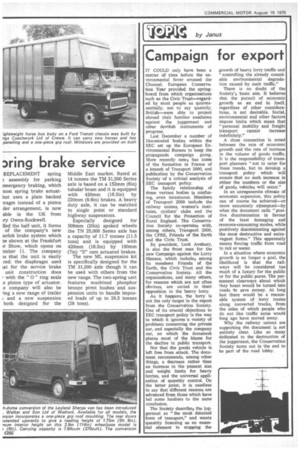Campaign for export
Page 36

If you've noticed an error in this article please click here to report it so we can fix it.
IT COULD only 'have been a matter 'of time before the environmental fever crossed the Channel. European Conservation Year provided the springboard from which organisations such as the Civic Trust—regarded by most people as quintessentially, not to say quaintly, British—were able to project abroad their familiar anathema against the juggernaut and other devilish instruments of progress.
Last December a number of like-minded bodies within the EEC set up the 'European Environmental Bureau to keep the propaganda campaign going. More recently news has come of the formation in 'France of a branch of Transport 2000, and publication by the Conservation Society of :a critical analysis of EEC transport policy.
The family relationship of these various bodies is 'confusing, even incestuous. Members of Transport 2000 include the railway unions, women's institutes, cyclists' clubs and the Council for the Protection of Rural England. The Conservation Society co-operates with, among others, Transport 2000, the CPRE, Friends of 'the Earth and the Civic Trust.
Its president, Lord Avebury, is also the front man for the new Campaign against the Lorry Menace, which includes among 'lts members Friends of the Earth, the Civic Trust and the Conservation Society. All the organisation's, and many others, for reasons which are not often obvious, are united in their opposition to the heavy lorry.
As it happens, the lorry is not the only target 'in the report from the Conservation Society. One of its crucial objections 'to EEC transport policy 'is the way in which it ignores a variety of problems concerning the private tar, and especially the company car, on which the docuanenit places most of the blame for the decline in public transport.
Not 'that the goods vehicle is left free from attaok. The document recommends, among other things, a decrease rather than an increase in 'the present size and weight limits for heavy lorries, and the universal application of quantity control. On the latter point, it Is needless to say that different reasons are advanced from those which have led some hauliers to the same conclusion.
The Society describes the juggernaut as "the most detested form of transport," and wants quantity licensing as an essential element in stopping the growth of heavy lorry traffic and "controlling the already considable environmental degradation caused by such traffic."
There is no doubt of the Sodiety's basic aim. It believes that the pursuit of economic growth as an end in itself, regardless of other considerations, is not desirable. Social, environmental and other factors impose limits which mean that "personal mobility and freight transport cannot increase indefinitely."
A close connection 'is noted 'between the rate of economic growth and the rate of increase in the vokune of goods traffic. It is the 'responsibility of transport planners "not to cater for these trends, 'but to develop a transport policy which will ensure that no such increase in either the numbers or the size of goods vehicles will occur."
In an unregenerate climate of economic expansion, 'this policy can of • course be achieved—or more accurately ,attempted—by What the document calls "positive discrimination 'in favour of the least damaging and resource-consuming modes, while positively discriminating against I he most destructive and extravagant forms." This apparently means forcing traffic from road to rail or water.
In a situation Where economic growth is no longer a goal, the likelihood is that the railways will 'be considered too much of a luxury for the public or for the public purse. The permanent clearways about which they boast would be turned into roads to gave money. At long last there would be a reasonable system of lorry routes along converted tracks, from the sides of which people who do not like 'traffic noise would long ago have moved away.
Why the railway unions are supporting the document is not entirely clear. Like. so many dedicated to the destruction of the juggernaut, the Conservation Society turns out in the end to be part of the road lobby.




































































































